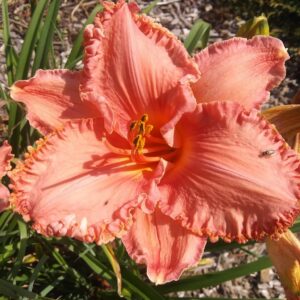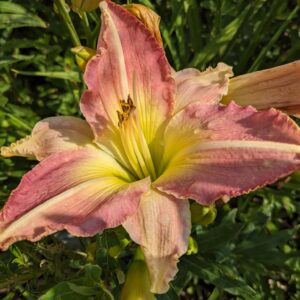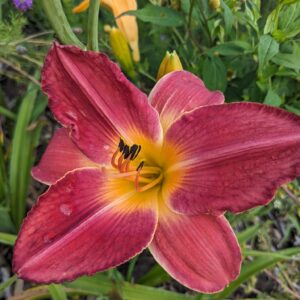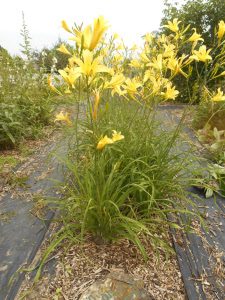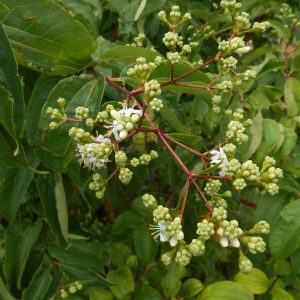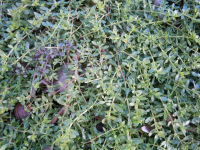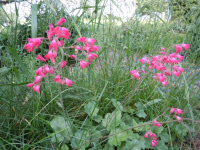Shop
Showing 385–392 of 785 results
-
Hemerocallis ‘Tangerine Dreams’
Profuse blooms. Ruffled edges frame its broad, recurved, vibrant tangerine-peachy petals with a stop-light yellow throat.
Tetraploid daylily. Our own hybrid. Flowers in July.
Profuse blooms. Ruffled edges frame its broad, recurved, vibrant tangerine-peachy petals with a stop-light yellow throat.Size: 20-30" tall
Care: Full sunOur own hybrid
-
Hemerocallis ‘Trigby Barres” Bob’s Tetraploid Daylily
Wavy-edged, pink petals form a 6-pointed star with a yellow throat as sunny as Bob’s disposition. Blooms mid-season Size: 28-35” tall, flowers 6 1/2” across
Tetraploid hybridized cultivar registered with the American Daylily Society in 2014
Wavy-edged, pink petals form a 6-pointed star with a yellow throat as sunny as Bob’s disposition. Blooms mid-season
Tetraploid hybridized cultivar registered with the American Daylily Society in 2014
Size: 26-32” tall, flowers 6” across
Robert Koehne (April 1971-September 2014) Bob was a good, personal friend and very enthusiastic gardener – perennially cheerful. He loved his wife and two children and daylily breeding. These daylilies are his “children” too. He bred them, named them, and registered this with the American Daylily Society. He named this after his siter Ann’s dog. He died of colon cancer too soon – before he could grow grey with Darby or see his kids or his daylilies grow up. We are growing on his daylilies. The proceeds go to his family.
Wavy-edged, pink petals form a 6-pointed star with a yellow throat as sunny as Bob’s disposition. Blooms mid-season Size: 28-35” tall, flowers 6 1/2” across
Tetraploid hybridized cultivar registered with the American Daylily Society in 2014
-
Hemerocallis ‘Watermelon Sherbert’ Tetraploid Daylily Z 4-9
Blossom a rich Merlo wine with thinnest white edging. The golden eye splays like the rays of sunshine. Mid-season bloom.
Robert Koehne (April 1971-September 2014) Bob was a good personal friend and very enthusiastic gardener – perennially cheerful. He loved his wife and two children and daylily breeding. These daylilies are his “children” too. He died of colon cancer too soon – before he could grow grey with Darby or see his kids or his daylilies grow up. We are growing on the daylilies Bob hybridized. The proceeds go to his family. This Daylily was nothing more than a seedling when Bob died. Tetraploid hybridized by Bob in 2013, only a seedling when Bob passed. We named it.
Blossom a rich Merlo wine with thinnest white edging. The golden eye splays like the rays of sunshine. Mid-season bloom.
Size: 20-24” ” tall, Flowers 6” across
Care: sun in most any soilRobert Koehne (April 1971-September 2014) Bob was a good personal friend and very enthusiastic gardener – perennially cheerful. He loved his wife and two children and daylily breeding. These daylilies are his “children” too. He died of colon cancer too soon – before he could grow grey with Darby or see his kids or his daylilies grow up. We are growing on the daylilies Bob hybridized. The proceeds go to his family. This Daylily was nothing more than a seedling when Bob died. Tetraploid hybridized by Bob in 2013, only a seedling when Bob passed. We named it.
-
Hemerocallis multiflorus Many-flower daylily in China called duo hua xuan cao Z 4-8
Elegant, tall, upright sunshine yellow flowers on this species daylily
Elegant, tall, upright sunshine yellow flowers on this species daylily. Grow for its height & unrivaled number of flowers. Each scape (leafless stem) will produce up to 100 blooms so that this blooms an extraordinary length of time, July-September
Size: 36-40” x 18-24”
Care: sun to part shade in moist well-drained soil
Native: openings in forests on hills in province Honan at Ki Kung Shan, China
Wildlife Value: attracts hummingbirdsThis species grown by Rev. C. Woolly Dod in Malpas, Cheshire England in 1880, The Garden, an Illustrated Weekly Journal of Gardening. Hemerocallis is Greek meaning “flower for a day.”
-
Heptacodium miconioides Seven son flower Z 5-9
Fragrant white flowers August –September then large clusters of burgundy calyces surround the fruit capsules as showy as the flowers on this large shrub or small tree. Ornamental tan and red-brown peeling bark and glossy heart-shaped leaves.
Fragrant white flowers August–September then in October clusters of burgundy-red calyces surround the fruit capsules as showy as the flowers on this large shrub or small tree. Ornamental tan and red-brown peeling bark and glossy heart-shaped leaves. “Avant Gardener” newsletter September 2011, calls it the “two-bloom tree,” saying, “more and more praise is being lavished on a rare late-flowering shrub/tree … even more showy (than the panicles of fragrant white flowers) is its ‘second bloom’, consisting of red-purple calyxes which remain after the flowers fall…well into October.”
Size: 15’ x 10-12’
Care: sun in moist to moist well-drained soil, drought tolerant. Prune in late winter to make it bushy, maintain shape or reduce size, if you wish.
Native: China
Wildlife Value: Attracts butterflies & bees, Deer resistant. Salt tolerant.
Awards: 2011 Great Plants Shrub of the Year; 2008 Plant Select®; Cary Award Distinctive Plants for New England & Pennsylvania Horticultural Society Gold, Missouri Botanical Garden Plant of MeritHepta means seven because each inflorescence has 7 flowers, and codium means flower. Collected initially by E H Wilson in 1907 at about 3000 feet in Hupeh Province. Rare in its native China.
-
Hernaria glabra Rupturewort Z 5-9
Tiny green flowers bloom atop tiny spreading foliage in July and August
ARCHIVED
Note: This is a plant not currently for sale. This is an archive page preserved for informational use.
Tiny green flowers bloom atop tiny spreading foliage in July and August.
Size: 2” x 12”
Care: sun moist well-drained to dry soil
Native: Europe, west & central AsiaGrown as a ground cover over graves in the 1800’s and “as a carpet bedding plant on account of its neat and compact dark green foliage,” Sanders 1913. Named for its old-time medicinal use, a remedy for hernias (powdered herb mixed with wine, ingested daily.)
-
Hesperaloe parviflora Red Yucca Z 6-9
Cerise scarlet trumpets up and down the flower spike in summer
OUT OF STOCK
Cerise scarlet trumpets up and down the flower spike in summer
Size: 3’ x 5’
Care: sun moist well-drained to dry soil
Native: Europe, west & central Asia
Wildlife Value: Attracts butterflies & hummingbirds. Deer and rabbit tolerant,Named by Dr. George Engelmann, a German physician and plant fanatic who emigrated to America in the early 1800’s, settling in St. Louis.
-
Heuchera sanguinea Coral bells, Alumroot Z 3-8
Coral red flowers in late spring through early summer. “One of the finest hardy perennials recently introduced …bright crimson flowers…very graceful,” Farquhar Catalog, 1893.
Coral red flowers in late spring through early summer. “One of the finest hardy perennials recently introduced …bright crimson flowers…very graceful,” Farquhar Catalog, 1893.
Size: 12" x 12"
Care: sun to part shade in moist well-drained soil.
Native: Western U.S.- Rocky MountainsGenus Heuchera named for Johann Heinrich von Heucher (1677-1747) professor of medicine at Wittenburg University. This species collected Be Dr. Frederick Adolph Wislizenus in the Porphyry Mountains of Llanos Mexico on the Col. Doiphan Expedition in 1846-7. Named by Dr. George Engelmann, (1809-1884) physician and avid botanist encouraging and supporting those who explored for plants. He emigrated from Germany and settled in St. Louis. Plant popular in the 1880’s.

